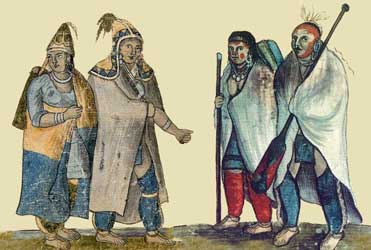Jean-Baptiste Bourgery
and Marie Gendre.
A Family Journey.
In the early 1600's the French colony in the New World was primarily populated by young single men. But Jean-Baptiste Bourgery brought his family; he and his wife Marie Gendre departed La Rochelle and crossed the ocean with their toddler Pierre. They had married about 1645. Marie came from Saintes, the daughter of Moïse Gendre and Jeanne Cosse. Her father was a maître serger who wove a twilled fabric.
Jean-Baptiste and Marie are among the first of our ancestors to move to North America. They left France around 1650 to settle in Trois-Rivières joining our other ancestors: Jean Lanctôt who was there by 1649, Étienne Vien's family who arrived by 1648 and the Godefroys.
Trois-Rivières.

It was the second town the French established, just upriver from ville de Québec. In the words of Champlain, the site of the small fur trading post was "elevated enough and covered with pines and evergreens along the edge of the river". The Saint-Maurice River pours into the Saint-Laurent through three channels, thus giving the area its name.
For centuries the Abenaki and Algonquin were drawn to the banks of the three rivers in the summer months to fish from their birch bark canoes. Hunting was good in the area. And they planted what the Canadians called blé d'Indie or Indian corn on the cob. Seeds and roots they collected supplemented their diet. They soon began trading with the French settlers.
The Indians were anxious to acquire metal goods such as axes, knives and needles. Their beautiful weavings were decorated with petite glass seed beads from the French. Larger ceramic beads made their way into chokers and breastplates.
The French sought furs and animal hides to send back to the European market. They eagerly adopted native farming techniques and attire such as snowshoes and moccasins to cope with the harsh Canadian winters brought on by the "little ice age" impacting the planet.
One thing both groups had in common was the animus of the Iroquois who wished to expand their territory.
Le siège des Trois-Rivières en 1653.

Despite an influx of settlers between 1648 and 1651, the population of the post declined since its inception in 1634. Indian raids grew in ferocity and became more frequent. In August 1652 M. Duplessis-Kerbodot, the Governor of Trois-Rivières led his newly formed militia to meet the threat but were ambushed and most died. Thomas Godefroy, our uncle, was captured and brought back to the warriors' village where he was burned at the stake.
This defeat spurred the captain of the militia, Pierre Boucher, to have a palisade built to protect the tiny village. The barrier did not encompass the surrounding farmland nor did it provide safe passage to the river.
Our family was living in the town when in June of 1653 the Iroquois began a siege. Forty or so Frenchmen, no doubt including Bourgery and Lanctôt, manned the wall with their Indian allies as the enemy burned crops and killed their livestock. Anyone venturing out faced certain death in the woods. But still the line held for three months against hundreds of invaders.
In August of 1653 Boucher parlayed with the aggressors. He had some knowledge of the Huron and their language and may have recognized some of the men who themselves had been captured by the Iroquois and conscripted into service. And too the attack may have lost some of its luster after so many months without victory. An agreement was reached and the siege ended much to the delight of the French.
It was an important victory. The governor of New France, Jean de Lauzon, remarked, "... si les ennemis eussent pris les Trois-Rivières, tout le pays était perdu (... if the enemy had taken Three Rivers, the whole country was lost.)"
- https://en.wikipedia.org/wiki/Little_Ice_Age
- The Curious 1653 Siege of Trois Rivières https://khronikosum.wordpress.com/tag/quebec/page/2/
- Le siège trifluvien https://grandquebec.com/histoire/siege-trois-rivieres/
- Le siege de Trois-Rivieres image from https://wikimonde.com/article/Si%C3%A8ge_des_Trois-Rivières
- "Our French Canadian Ancestors", volume, chapter 9, page 104
- Jetté, René, Dictionnaire généalogique des familles du Quebec des origines à 1730 (Montréal: Les Presses de l'Université de Montréal, 1983)
- Dictionnaire généalogique des familles Canadiennes depuis la Fondation de la Colonie Jusqu'a Nos Jours, Tanguay, L'Abbé Cyprien, Baltimore: Genealogical Publishing Company, 1967
- Compiled image 18th-century watercolor by an unknown artist. Courtesy of the City of Montreal Records Management & Archives, Montreal, Canada.
